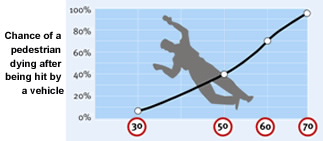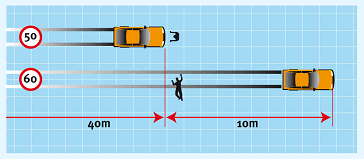 How Does Speed affect your Driving?
How Does Speed affect your Driving?
Drivers travelling too fast for the conditions are the single biggest road safety issue in New Zealand today. Drivers must constantly choose the right speed for the conditions. Conditions include the road, weather, light and traffic.
Speed and the facts
In 2005 speeding was a contributing factor in 112 fatal traffic crashes, 426 serious injury crashes and 1,269 minor injury crashes. These crashes resulted in 130 deaths, 579 serious injuries and 2079 minor injuries.
The total social cost of crashes involving drivers speeding was about $750 million which is approximately a quarter of the social cost associated with all injury crashes.
Drivers
When a pedestrian is hit by a vehicle, the severity of their injuries is related to the impact speed.
The probability of death for a pedestrian rises steeply from 10 percent at an impact speed of 30 km/h and 70 percent at 50 km/h.
The risks for the elderly and young children, are higher.
Seasonal danger times for children are the beginning and end of school holidays.
Roads
Lots of New Zealand's rural road network was built under an 80-km/h open-road speed-limit regime so travelling at 100km/h is too fast.
Drivers need to slow down – especially for winding roads.
Travelling too fast for corners leads to difficulty keeping left, staying in the lane, and not crossing the centre line.
Weather and light
Bad weather and light and will affect traction, visibility and vehicle control. Drive to these conditions to ensure you have as much control as possible.
Traffic
The most dangerous days of the week are Friday and Saturday. More crashes occur in rush hours, particularly after school. Seasonal danger times include the beginning and end of school holidays. Consider traffic danger zones – how fast are you driving near a shopping centre, sports arena, factory or school?
Hazards
Consider traffic danger zones – how fast are you driving near a shopping centre, sports arena, factory or school?
We cant beat the law of physics

once hazard is first viewed
The faster you’re going, the greater the distance you will travel while braking in reaction to a hazard = stopping distance.
A pedestrian hit at 44km/h is likely to die or be severely injured

When a pedestrian is hit by a vehicle, the severity of their injuries is related to the impact speed.
The probability of death for a pedestrian rises steeply from 10 percent at an impact speed of 30 km/h and 70 percent at 50 km/h.
The risks for the elderly and young children, are higher.
Seasonal danger times for children are the beginning and end of school holidays.
Speed and fuel consumption
- At high vehicle speeds, fuel use increases due to poorer fuel efficiency of the vehicle.
- Fuel efficiency has been estimated to peak at 89km/h for cars and light trucks and at 80km/h for heavy diesel trucks.
The myth – speeding gets me there faster
The reality is that speeding doesn’t save much time.
A study was undertaken which compared drivers travelling on a 60 km trip. Those who drove aggressively (heavy acceleration and braking) arrived just five minutes ahead of those drivers who drove smoothly and to the conditions. Not only were the aggressive drivers putting themselves and others at far greater and needless risk for the sake of a mere five minutes. In the above study they used 30% more fuel!
Slowing down is better for the environment
- As speed increases above 50km/h, the level of emissions of Carbon Monoxide (CO), Oxides of Nitrogen (NOx), and particulates increases.
- At low speeds in congested traffic, gaseous emissions such as Volatile Organic Compounds (VOCs) and CO are high.
- At high speeds, emissions of Carbon Dioxide (CO2) are high, which contributes to the greenhouse effect. Motor vehicles are the largest source of CO2 emissions in New Zealand.
- Reducing the mean speed of vehicles reduces the level of gaseous emissions.
- Vehicle noise increases with increasing speed due to noise from the tyre-road interaction.
|
| Make a Booking |
| Our feedbacks or testimonials |
| For Fast response Ph / TXT : 027 287 9893 |
|
Type of Licence |
Pass Rate |
|---|---|
| Full standard | 100% |
| Overseas conversion | 100% |
| Restricted license | 98% |
| Heavy vehicle | 100% |
| Motorbike | 100% |
I Want To.... |
| ....Do Driving lesson |
| ....Do Driving Assessments. |
.jpg)
